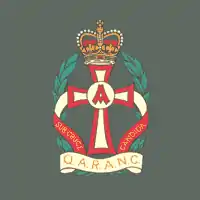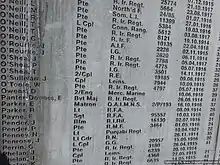Queen Alexandra's Royal Army Nursing Corps
Queen Alexandra's Royal Army Nursing Corps (QARANC; known as the QAs) is the nursing branch of the British Army Medical Services.
| Queen Alexandra's Royal Army Nursing Corps | |
|---|---|
 Cap Badge of the QARANC | |
| Active | 1949 – present |
| Country | |
| Branch | |
| Role | Medical support |
| Part of | Army Medical Services |
| Garrison/HQ | Staff College, Camberley |
| Nickname(s) | The QAs |
| Motto(s) | Sub cruce candida (Under the White Cross) |
| March | Quick: Grey and Scarlet[1] |
| Commanders | |
| Colonel-in-Chief | The Duchess of Edinburgh GCVO CD |
| Chief Nursing Officer (Army) | Colonel Paul Jackson |
| Insignia | |
| Tactical Recognition Flash |  |

History
Although an "official" nursing service was not established until 1881, the corps traces its heritage to Florence Nightingale, who was instrumental in lobbying for the support of female military nurses.[3] The Army Nursing Service, which had been established in 1881, and which from 1889 provided Sisters for all Army hospitals with at least 100 beds,[4] had only a small number of nurses in its employ. In 1897, in an effort to have nurses available if needed for war, the service was supplemented by Princess Christian's Army Nursing Service Reserve (PCANSR). Nurses registered for the service and by the beginning of the First Boer War the reserve had around 100 members, but swelled its membership to over 1400 during the conflict. PCANSR eventually became the Queen Alexandra's Imperial Military Nursing Service.[5] On 27 March 1902,[6] Queen Alexandra's Imperial Military Nursing Service (QAIMNS) was established by Royal Warrant, and was named after Queen Alexandra, who became its president.[7] In 1949, the QAIMNS became a corps in the British Army and was renamed as the Queen Alexandra's Royal Army Nursing Corps. Since 1950 the organisation has trained nurses, and in 1992 men were allowed to join.[4]
The associated Queen Alexandra's Royal Army Nursing Corps Association is a registered charity. Queen Alexandra was president from 1902 until her death in 1925. The following year she was succeeded by Queen Mary.[8]
Territorial Force Nursing Service
The Territorial Force Nursing Service (TFNS) was originally formed to staff the territorial force hospitals at home, and the majority of its members spent their service during World War I in the United Kingdom, not only in the 25 territorial hospitals, but also in hundreds of auxiliary units throughout the British Isles. Within a short time they were also employed in the eighteen territorial hospitals abroad, and alongside their QAIMNS colleagues in military hospitals and casualty clearing stations in France and Belgium, Malta, Salonica, Gibraltar, Egypt, Mesopotamia and East Africa.[9]
Territorial Army Nursing Service
The Territorial Army Nursing Service (TANS) was formed in 1920, when the Territorial Force was renamed the Territorial Army. It existed until 1949, when both regular and reserve nurses joined the QARANC. Territorial Army nurses served alongside QAIMNS nurses all over the world, and in all campaigns during World War II.[9]
Ranks
The initial ranking system used by the QAIMNS was as follows.
| QAIMNS rank | Equivalent Army rank (from 1941) |
|---|---|
| Staff Nurse[10] | |
| Sister | Lieutenant |
| Senior Sister[11] | Captain |
| Matron | Major |
| Principal Matron | Lieutenant-Colonel |
| Chief Principal Matron[12] | Colonel |
| Matron-in-Chief | Brigadier |
Senior Corps Appointments
The Colonel In Chief is The Duchess of Edinburgh GCVO GCStJ CD. The Corps has two Colonels Commandant, Colonel Andrea Lewis RRC, who was appointed in 2023, and Colonel Kevin Davies MBE RRC OStJ TD DL, who was appointed in 2017.[13]
In January 2016 a new post, Chief Nursing Officer (Army), replaced the role of Matron-in-Chief and the Director Army Nursing Services.[13]
List of Chief Nursing Officers (Army)
List of Matrons-in-Chief QAIMNS/QARANC
.jpg.webp)
- Dame Sidney Browne (1902–1906)
- Caroline Keer (1906–1910)
- Dame Ethel Becher (1910–1919)[15]
- Dame Maud McCarthy (1914–1919) (France & Flanders) [15]
- Dame Sarah Oram (1915–1919) (Middle East)[15]
- Beatrice Isabel Jones (1916–1920) for Mesopotamia[16][17]
- Dame Anne Beadsmore Smith (1919–1924)
- Florence Hodgins (1924–1928)
- Rosabelle Osborne (1928–1930)
- Marguerite Medforth (1930–1934)
- Daisy Martin, 1934–1938)
- Catherine Roy (1938–1940)
- Dame Katharine Jones (1940–1944)
- Dame Louisa Wilkinson (1944–1946)
- Lilian Hunnings (1946–1948)
- Brigadier Dame Anne Thomson (1948–1952)
- Brigadier Dame Helen Gillespie (1952–1956)
- Brigadier Dame Monica Golding (1956–1960)
- Brigadier Dame Barbara Cozens (1960–1964)
- Brigadier Dame Margot Turner (1964–1968)
- Brigadier Barbara Gordon (1968–1973)
- Brigadier Helen Cattanach (1973–1977)
- Brigadier Joan Moriarty (1977–1981)
- Brigadier Vera Rooke (1981–1984)
- Brigadier Rita Hennessy (1985–1989)
- Brigadier Jill Field (1989–1992)
- Brigadier Hilary Dixon-Nuttall (1992–1995)
- Brigadier Jane Arigho (1995–1999)
- Colonel Bridget McEvilly, 1999–2002)
- Colonel Kathy George (2002–2005)
- Colonel John Quinn (2005–2008)
- Colonel Wendy Spencer (2008–2011)
- Colonel Pete Childerley (2011–2013)
- Colonel David Bates (2013-2016)
List of Matrons-in-Chief TFNS/TANS
- Dame Sidney Browne (1909–1920)
- Dame Maud McCarthy (1920–1925)
- Dame Anne Beadsmore Smith (1925–1931)
- Rosabelle Osborne (1931–1936)
- Agatha Phillips (1936–1940)
See also
Other Army Medical Services
- Royal Army Medical Corps (RAMC)
- Royal Army Veterinary Corps (RAVC)
- Royal Army Dental Corps (RADC)
Other Armed Forces Nursing Services
References
- "Grey and Scarlet – The Queen Alexandra's Royal Army Nursing Corps Quick March" (PDF).
- Morley, James. "Matron Elizabeth Kelly Parker Queen Alexandra's Imperial Military Nursing Service. Died Monday 16 October 1916". A Street Near You.
- "Army Medical Services". www.army.mod.uk.
- Gordon, Peter; Doughan, David (2001). Dictionary of British Women's Organisations, 1825–1960. p. 120.
- Piggott, Juliet (1990). Queen Alexandra's Royal Army Nursing Corps. Havertown, England: Pen and Sword. pp. 37, 53. ISBN 978-1-4738-1739-5.
- Juliet Piggott, Famous Regiments: Queen Alexandra's Royal Army Nursing Corps (Leo Cooper Ltd, 1975) p. 38
- "Naval & Military intelligence – Imperial Military Nursing Service". The Times. No. 36727. London. 28 March 1902. p. 8.
- "Skirt worn by Sister A Stewart Wyatt, Queen Alexandra's Imperial Military Nursing Service, 1902". National Army Museum. Retrieved 2 October 2016.
- "History of British Army Nursing". Queen Alexandra's Royal Army Nursing Corps Association. Retrieved 9 May 2019.
- Phased out before 1944.
- Introduced at some time between 1902 and 1919 as Assistant Matron.
- Introduced in the 1920s.
- "Command & Control of Army Nurses". Queen Alexandra's Royal Army Nursing Corps Association. Retrieved 10 May 2019.
- "Today we wish a fond farewell to Col... - QARANC Association". www.facebook.com. Retrieved 1 February 2023.
- Such was the expansion of QAIMNS during the First World War that there were three Matrons-in-Chief simultaneously (Becher, McCarthy & Oram).
- Newman, Vivien (2014). We Also Served: The Forgotten Women of the First World War. Barnsley, South Yorkshire, England: Pen and Sword. p. 111. ISBN 978-1-4738-4527-5.
- "The Passing Bell" (PDF). The British Journal of Nursing. London, England: Royal British Nurses Association. 66 (1713): 66. 29 January 1921. Retrieved 3 September 2016.